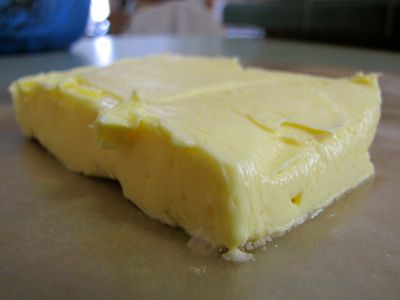If you are fortunate enough to have access to raw milk or cream like I am, congratulations! All the needed enzymes and bacteria are still in place and you need nothing but good ol’ raw cream and a jar with a lid to make cultured butter.
If you don’t have access to raw cream, I am so very sorry. You will need one pint of cream (No additives. Pure, glorious cream. Check the label) and three tablespoons kefir, yogurt, or cultured buttermilk. Not vanilla kefir or yogurt. Pure, plain kefir or yogurt. And a jar with a lid. OR… If you happen to have some creme fraiche looking for a purpose, skip the pasteurized cream and kefir and just use it (and begin at step two, below).
Store raw cream, or pasteurized cream with kefir or yogurt mixed in (see above for amounts) in a very clean glass jar with the lid screwed on well at room temperature. If it’s raw, it only needs to sit overnight (or 12 hours if it’s winter). If it’s pasteurized (I’m sorry again), keep it sitting out for 12-24 hours, depending on how warm room temperature is (less time for warm, more time for cool). Once it starts looking thicker (swish it around a bit to test it’s thickness), it’s butter time.
You can either churn your cultured cream with an electric mixer (if you own a Kitchen-Aid, use the whisk attachment) or a food processor. The food processor seems to take less time, the mixer takes several minutes. The problem I sometimes have with the food processor (mine is eleven years old, so the newer ones might work better), is that it sometimes leaks the precious cream, and that’s just painful for me. Crank the chosen appliance on. Once you start seeing lumps, you have butter! And buttermilk! Ah, buttermilk! It’s all starting to make sense…
Drain the buttermilk into a bowl. Now use a spoon to squeeze any more buttermilk out of the butter and into the buttermilk bowl.
Rinse the butter with cold water and push out the water with a spoon like you did to get the buttermilk out. Continue doing this (rinse and squeeze) until the water that you squeeze out of the butter is clear. If you don’t do this and there’s still buttermilk in your butter, the butter goes rancid. Rancid butter tastes nasty. Rancid = free-radicals. Free-radicals bad. Squish the butter into a glass storage container and pour buttermilk into a glass jar (remember the picture way up at the top? Yep.)
And there you have it, folks! Cultured butter for the cultured foodie. No need to salt it; it’s flavor is perfect by itself. How long will they keep, you ask? It depends on how fresh your cream was. The butter and buttermilk will keep for a few weeks in the fridge if your cream was fresh. Now go! Make some cultured butter! Your tummy will thank you.
Cultured Butter & Buttermilk
We’re making cultured butter and buttermilk here, this is serious stuff. Seriously simple. Seriously. Why would you want cultured butter over regular butter? Cultured butter has good bacteria. You know, probiotics? Good for your gut? Supports immune system? Trims tummy fat? Yeah, that kinda bacteria. The good kind.
